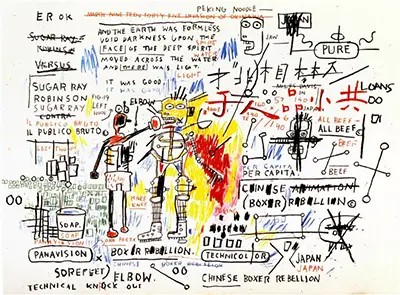The original design was created in 1982/1983 but as recently as 2018 there was a limited edition series of screenprints completed which were signed and distributed by the estate of the artist. Two central figures, both boxers, take your focus initially, before the whole series of texts draws your eyes around the canvas. The style used across Boxer Rebellion is entirely typical of Basquiat, with his figures created from relatively simple lines, with only the occasional solid form. The perspective is entirely flat and most would describe them as cartoon-like. This was the artist at his expressive best, taking ideas from deep in his soul and allowing them to appear on canvas, just as they came out. There are some tightly worked areas of orange, red and pink colours, where one can still see the original strokes, but the majority of the artwork is of a white background with black text upon it.
The text is entirely hard to understand, drawing together seemingly random themes such as boxing and China, as well as some financial terms. Basquiat was a highly complex individual who perhaps used these paintings as a form of therapy, removing ideas from his own mind onto the paper on which he worked and allowing them to escape from his enclosed mind. He suffered mental health issues and was homeless too, but somehow managed to overcome many hurdles to establish himself as a key part of the New York art scene that would help to put American art at the top of the international art would for a period during the 20th century. His contributions are celebrated today just as much, if not more, than they were then and there has also been a greater interest in Afro Caribbean artists recently, which has also helped Basquiat's legacy to continue to thrive.
One will not be surprised to learn that this artist was also a poet, hence the scrawls of text across this, and many other, paintings from his career. His style is termed by most as Neo-Expressionism, though there was also a clear link to Primitivism which derived from his African roots and passionate interest in that particular culture. His political views surrounding the experiences of his own community within the US would creep into his work over time and feels particularly relevant today considering some recent events across the country. He was ahead of his time in many ways, both in terms of his artistic style, but also very much in the content and messages that he was attempting to communicate to a wider audience.


